| |
| |
Photographer,
Location |
Images |
Comments |
|
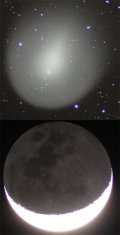
|
Günther
Strauch,
Borken, NRW, Germany
Nov. 14, 2007 |
#1 |
Now
the dimension of the comet holmes is the same as the moon
size. But only at the sky, but not in reality. Canon EOS
20D, Refraktor 100/1000mm, Comet Holmes 1600 ASA, 180 Secondes
exposure |
|
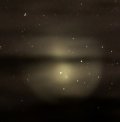
|
Mike
Salway,
Central Coast, NSW Australia
Nov. 13, 2007 |
#1,
#2, more |
My
view to the North is blocked by trees, so I hadn't seen
Comet Holmes until Tuesday night, when we went up to Mangrove
Mountain pony club for some dark sky time. The view to the
North there was pretty good, but there were still trees
which blocked about 4.5° up off the horizon. We got our
first visual look at the comet through binos, and wow it
was large, but diffuse at the same time. So here's Comet
Holmes, at 12:40am 14th November at 5° altitude. Unfortunately
trees still blocked most of the view, because the refractor
is shorter off the ground than my height - so even though
I could see it clearly while standing, the refractor could
not. Anyway, the trees give it a bit of atmosphere.. I would've
liked the comet to have cleared the trees but i'll take
what I can. Images taken with the ED80 & 350D, guided with
the DMK. The first 1 is a stack of 3 x 60s subs. The second
shot is a single 90s exposure just before it went behind
the club-house at the Pony Club. All @ ISO800. I'm not sure
if i'll get the chance to image this again, but I'll certainly
try and get out again to take some widefield shots. |
|
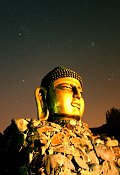
|
Taeyeon
Kim,
Wawoojungsa Temple, Youngin City Korea
Nov. 6, 2007 |
#1,
#2 |
Canon
350D EFs 10-22mm lenz, f3.5 iso400, 90s exposure |
|
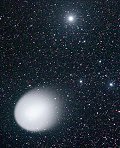
|
Pete
Lawrence,
Selsey, West Sussex, UK
Nov. 14, 2007 |
#1 |
Here
are two shots of Holmes showing the large coma on the right,
so large that it now passes in front of many faint background
stars in its apparent path across the sky. This path is
taking it closer to Alpha Persei or Mirfak which is clearly
shown in the image on the left. |
|

|
Katy Stetson and John Stetson,
Falmouth, Maine
Nov. 10, 2007 |
#1 |
My daughter's first impression of the comet was that it was a (celestial) jellyfish. When we processed this image, we were amazed at the number of stars that can be seen clearly through this translucent comet.
|
|
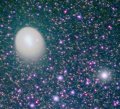
|
Marco
Fulle,
Sistiana (TS) Italy
Nov. 12, 2007 |
#1 |
On
12 November a blue ion tail about 4 degrees long was still
well visible SSW of the huge grey dust coma. Photo details:
12 Nov 2007 20h30m-21h00m UT. 8 x 3min + 4 x 30 sec exposure.
FujiS3 @ 800ISO. f=135mm f/2 @ f/2.8 field 5 x 5 degrees.
|
|
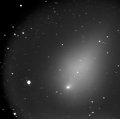
|
David
Lee,
Victoria BC Canada
Nov. 13, 2007 |
#1,
more |
Tonight
was the first clear night I was able to get out and image
Comet Holmes. It was 2 degrees centigrade and it didn't
take long for the equipment to frost up. Fortunately I was
running with my new dew removal system that worked like
a charm! When I looked in to the eyepiece I noticed how
much the comet had enlarged and become much more diffuse.
The head now has a beautiful "flame" appearance. Telescope:
Televue NP101is 101mm/5.4 Sensor: Meade DSI Pro Exposure:
15 stacked exposures of 30 seconds using MaxDSLR; fine tuning
using Adobe Photoshop CS2 |
|

|
Suresh Mohan,
Mahabalipuram, South India
Nov. 11, 2007 |
#1,
|
Canon 350D,ISO 400.20 exposures of one minute each stacked and aligned in images plus
|
|
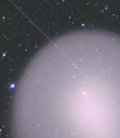
|
Giancarlo
Vignale,
Sanremo Italy
Nov. 14, 2007 |
#1 |
17P/Holmes
comet+Mirphak+satellite Pentax Sduf II Canon 20D modif.
exp.120 secon. 800 asa 14 Nov. 2007 h 17:45 T.U. |
|
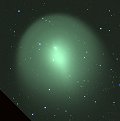
|
Oleg Tuchin,
Samara, Russia
Nov. 11, 2007 |
#1,
more |
The snapshot is made by November 11, 2007 UT 16h. A telescope, diameter of 100 mm, F = 1000 mm. Canon 350D. 53 staff for 30 seconds is combined.
|
more
images (Nov. 13-14): from
Simone Bolzoni of Busto Arsizio, northern Italy; from
Curatsu Mihai of Bucharest, Romania; from
Chuck Hunt of Congress, Ohio; from
Tamas Ladanyi of Veszprem city in Hungary; from
Luca Basili of Rome - Italy; from
George Varros of Mount Airy, Maryland USA; from
Karl Kuehn of Greene, NY; from
John S. Gianforte of Durham, New Hampshire; from
Wade B Clark Jr of Northwest Washington State near Lyman;
from
ALBERTO QUIJANO VODNIZA of Pasto, Nariño. Colombia
more
images (Nov. 11-12): from
Alfredo Garcia Jr of Torrance, CA; from
Roger Marical of Est Rouen, Normandy, France;
|
|